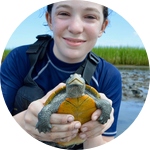About This Project
Green anoles (Anolis carolinensis) morphs from green to brown, and it is not known why. In this experiment, the effect of stress levels and the correlation of light levels and temperature on the frequency and duration of color change in A. carolinensis will be tested. I hypothesize that stress levels in addition to environmental conditions such as light and temperature affect color change in A. carolinensis. This research will provide insight into an unusual behavior of a common lizard.
Ask the Scientists
Join The DiscussionWhat is the context of this research?
The green anole (Anolis carolinensis) has the ability to change color from bright green to dark brown. While scientists know how this color change occurs, it is not yet know why. There have been multiple hypotheses about the color change before, including for advertisement and social signaling, thermoregulation, and as a result of stress. None of these hypotheses have been consistently supported with field studies, therefore a controlled environment is more likely to produce consistent data that will either support or deny the hypotheses.
What is the significance of this project?
Green anoles are common in the wild and in the pet trade. Despite this, a controlled experiment trying to discover the reason for the color change has never been conducted. If it is found that green anoles turn brown as a result of stress, that would mean the color change of green anoles is indicative of their brain function and ‘emotions’. This means that they are able to wear their ‘emotions’ on the outside, so understanding the effects of stress on them is easily observable and non-invasive. In addition, due to their easy care requirements, and the simplicity of replicating its natural environment, green anoles are perfect for experimental work, making them a perfect model organism for the genus Anolis. This could open a window into the effects of environmental stressors on anoles.
What are the goals of the project?
To determine the cause of the color change in green anoles, I will be creating a basic model of the anoles natural habitat to test and house them in. Anoles will be tested separately to ensure that conditions in terrariums are kept constant. To test stress, a disk will be pushed from one side of the terrarium to the other multiple times. There are 3 scenarios to test the correlation between light levels and temperature on color change: lights on, heat off; lights on, heat on; and light off, heat off. This will determine if anoles change color for thermoregulation. Color will be scored as a ratio of green to brown intensities, where a larger score indicates a greener color. It is likely that anoles change color as a result of stress, and not for thermoregulation purposes.
Budget
1) The materials required to house and care for anoles. I will be creating basic setups to test and house the anoles in. Terrariums, lighting and heating (for the community tank), food, supplements, and decorations to provide anoles an area to hide/climb will be purchased with the funding.
2) 40 female green anoles will be purchased to use in the study. Males cannot be housed together, so testing only females is more feasible.
3) The equipment that will be used to test both stimuli. This includes lighting and heating (for the testing tanks) as well as a red disk to stress the anoles.
4) Cameras to record the frequency and duration of color change in the anoles. Because the tanks will be in an isolated area so that outside conditions (i.e. a person walking by) does not affect the anoles behavior, I will not be able to sit in the room with them and observe their response to the stimuli.
5) This will allow more anoles to be tested at a time, hence decrease the duration of the study.
Endorsed by
 Project Timeline
Project Timeline
Housing terrariums will be set up by October 2019 and 40 female anoles will be purchased. After a 2 week observation period to ensure the health of the anoles, testing will commence. Testing will begin October 28, 2019 and will end December 4, 2020. On December 2020 I will be analyzing data and compiling findings into a research paper. 4 anoles will be tested per week, with 5 tests being conducted on each anole throughout the week.
To see more about the experiment setup, click here.
Oct 02, 2019
Project Launched
Oct 14, 2019
40 female green anoles arrive and 2 week observation period begins.
Oct 28, 2019
2019-2020 testing session begins
May 22, 2020
2019-2020 testing session ends (due to summer break)
Sep 14, 2020
2020 testing session begins.
Meet the Team
Victoria Pagano
Hello! My name is Victoria Pagano and I am currently a junior at Princeton High School. I love herpetology and would like to pursue a career in the field, and this study is a major step in that direction. All funding is greatly appreciated and I hope that I can get you all as excited about this project as I am!
My experience includes two prior independent research projects; one on the effect of increased acidity on the Chesapeake Bay ecosystem, and the other is a survey of chytrid fungus in central New Jersey. I am the leader of the PHS “Cool” Blooded Club which explores native and captive herpetofauna, and am creating the New Jersey Herpetological Society as part of my Girl Scout Gold Award.
It’s time to start this project...
Lizard Lovers Unite!
Project Backers
- 16Backers
- 100%Funded
- $1,464Total Donations
- $43.06Average Donation


